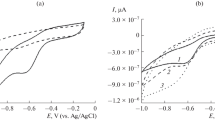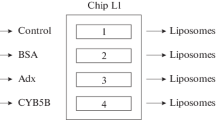Abstract
In mammals, steroid hormones are synthesized from cholesterol that is metabolized by the mitochondrial CYP11A1 system leading to pregnenolone. The reduction equivalents for this reaction are provided by NADPH, via a small electron transfer chain, consisting of adrenodoxin reductase (AdR) and adrenodoxin (Adx). The reaction partners are involved in a series of transient interactions to realize the electron transfer from NADPH to CYP11A1. Here, we compared the ionic strength effect on the AdR/Adx and Adx/CYP11A1 interactions for wild-type Adx and mutant AdxS112W. Using surface plasmon resonance measurements, stopped flow kinetic investigations and analyses of the product formation, we were able to obtain new insights into the mechanism of these interactions. The replacement of serine 112 by tryptophan was demonstrated to lead to a dramatically decreased k off rate of the Adx/CYP11A1 complex, resulting in a four-fold decreased K d value and indicating a much higher stability of the complex involving the mutant. Stopped flow analysis at various ionic strengths and in different mixing modes revealed that the binding of reduced Adx to CYP11A1 seems to display the limiting step for electron transfer to CYP11A1 with pre-reduced AdxS112W being much more efficient than wild-type Adx. Finally, the dramatic increase in pregnenolone formation at higher ionic strength using the mutant demonstrates that the interaction of CYP11A1 with Adx is the rate-limiting step in substrate conversion and that hydrophobic interactions may considerably improve this interaction and the efficiency of product formation. The data are discussed using published structural data of the complexes.





Similar content being viewed by others
Abbreviations
- AdR:
-
Recombinant wild-type adrenodoxin reductase
- Adx:
-
Recombinant wild-type adrenodoxin
- CYP:
-
Cytochrome P450
- CYP11A1:
-
Cytochrom
- P450scc:
-
Side chain cleavage enzyme from bovine adrenals
- NADPH:
-
Nicotinamide adenine dinucleotide phosphate
- FAD:
-
Flavine adenine dinucleotide
- SPR:
-
Surface plasmon resonance
References
Archakov AI, Ivanov YD (2011) Application of AFM and optical biosensor for investigation of complexes formed in P450-containing monooxygenase systems. Biochim Biophys Acta 1814(1):102–110
Beckert V, Bernhardt R (1997) Specific aspects of electron transfer from adrenodoxin to cytochromes P450 scc and P45011 beta. J Biol Chem 272(8):4883–4888
Bernhardt R (1996) Cytochrome P450: structure, function, and generation of reactive oxygen species. In: Reviews of physiology biochemistry and pharmacology, vol 127. Springer, Berlin, pp 137–221 (Berlin 33)
Bernhardt R, Waterman MR (2007) Cytochrome P450 and steroid hormone biosynthesis. In: Sigel A, Sigel H, Sigel RKO (eds) The ubiquitous roles of cytochrome P450 proteins, vol 3. Wiley, Chichester
Berwanger A, Eyrisch S, Schuster I, Helms V, Bernhardt R (2010) Polyamines: naturally occurring small molecule modulators of electrostatic protein–protein interactions. J Inorg Biochem 104(2):118–125
Brandt ME, Vickery LE (1993) Charge pair interactions stabilizing ferredoxin–ferredoxin reductase complexes—identification by complementary site-specific mutations. J Biol Chem 268(23):17126–17130
Chu JW, Kimura T (1973) Studies on adrenal steroid hydroxylases—complex-formation of hydroxylase components. J Biol Chem 248(14):5183–5187
Ewen KM, Kleser M, Bernhardt R (2010) Adrenodoxin: the archetype of vertebrate-type [2Fe-2S] cluster ferredoxins. Biochim Biophys Acta 9:9–12
Grinberg AV, Hannemann F, Schiffler B, Muller J, Heinemann U, Bernhardt R (2000) Adrenodoxin: structure, stability, and electron transfer properties. Proteins Struct Funct Genet 40(4):590–612
Hannemann F, Rottmann M, Schiffler B, Zapp J, Bernhardt R (2001) The loop region covering the iron-sulfur cluster in bovine adrenodoxin comprises a new interaction site for redox partners. J Biol Chem 276(2):1369–1375
Hannemann F, Bichet A, Ewen KM, Bernhardt R (2007) Cytochrome P450 systems—biological variations of electron transport chains. Biochimica Et Biophysica Acta-General Subjects 1770(3):330–344
Huang JJ, Kimura T (1973) Studies on adrenal steroid hydroxylases—oxidation-reduction properties of adrenal iron-sulfur protein (adrenodoxin). Biochemistry 12(3):406–409
Keizers PHJ, Mersinli B, Reinle W, Donauer J, Hiruma Y, Hannemann F, Overhand M, Bernhardt R, Ubbink M (2010) A solution model of the complex formed by adrenodoxin and adrenodoxin reductase determined by paramagnetic NMR spectroscopy. Biochemistry 49(32):6846–6855
Lambeth JD, Seybert DW, Kamin H (1979) Ionic effects on adrenal steroidogenic electron-transport—role of adrenodoxin as an electron shuttle. J Biol Chem 254(15):7255–7264
Miller WL (1995) Mitochondrial specificity of the early steps in steroidogenesis. J Steroid Biochem Mol Biol 55(5–6):607–616
Muller JJ, Lapko A, Bourenkov G, Ruckpaul K, Heinemann U (2001) Adrenodoxin reductase-adrenodoxin complex structure suggests electron transfer path in steroid biosynthesis. J Biol Chem 276(4):2786–2789
Muller JJ, Lapko A, Ruckpaul K, Heinemann U (2003) Modeling of electrostatic recognition processes in the mammalian mitochondrial steroid hydroxylase system. Biophys Chem 100(1–3):281–292
Omura T, Sato R (1964) Carbon monoxide-binding pigment of liver microsomes. J Biol Chem 239(7):2370–2376
Porter TD, Larson JR (1991) Expression of mammalian P450 s in Escherichia coli. Methods Enzym 206:108–116
Sagara Y, Takata Y, Miyata T, Hara T, Horiuchi T (1987) Cloning and sequence-analysis of adrenodoxin reductase cDNA from bovine adrenal-cortex. J Biochem 102(6):1333–1336
Sagara Y, Wada A, Takata Y, Waterman MR, Sekimizu K, Horiuchi T (1993) Direct expression of adrenodoxin reductase in Escherichia coli and the functional characterization. Biol Pharm Bull 16(7):627–630
Schiffler B, Bernhardt R (2003) Bacterial (CYP101) and mitochondrial P450 systems—how comparable are they? Biochem Biophys Res Commun 312(1):223–228
Schiffler B, Kiefer M, Wilken A, Hannemann F, Adolph HW, Bernhardt R (2001) The interaction of bovine adrenodoxin with CYP11A1 (cytochrome P450(scc)) and CYP11B1 (cytochrome P450(11 beta))—acceleration of reduction and substrate conversion by site-directed mutagenesis of adrenodoxin. J Biol Chem 276(39):36225–36232
Schiffler B, Zollner A, Bernhardt R (2004) Stripping down the mitochondrial cholesterol hydroxylase system, a kinetics study. J Biol Chem 279(33):34269–34276
Shikita M, Hall PF (1974) Stoichiometry of conversion of cholesterol and hydroxycholesterols to pregnenolone (3beta-hydroxypregn-5en-20-one) catalyzed by adrenal cytochrome P450. Proc Natl Acad Sci USA 71(4):1441–1445
Sugano S, Morishima N, Ikeda H, Horie S (1989) Sensitive assay of cytochrome-P450SCC activity by high-performance liquid-chromatography. Anal Biochem 182(2):327–333
Uhlmann H, Beckert V, Schwarz D, Bernhardt R (1992) Expression of bovine adrenodoxin in Escherichia coli and site-directed mutagenesis of (2-Fe-2S) cluster ligands. Biochem Biophys Res Commun 188(3):1131–1138
Uhlmann H, Kraft R, Bernhardt R (1994) C-terminal region of adrenodoxin affects its structural integrity and determines differences in its electron-transfer function to cytochrome-P-450. J Biol Chem 269(36):22557–22564
Usanov SA, Graham SE, Lepesheva GI, Azeva TN, Strushkevich NV, Gilep AA, Estabrook RW, Peterson JA (2002) Probing the interaction of bovine cytochrome P450scc (CYP11A1) with adrenodoxin: evaluating site-directed mutations by molecular modeling. Biochemistry 41(26):8310–8320
Vickery LE (1997) Molecular recognition and electron transfer in mitochondrial steroid hydroxylase systems. Steroids 62(1):124–127
Vijayakumar S, Salerno JC (1992) Molecular modeling of the 3D structure of cytochrome P-450SCC. Biochim Biophys Acta 1160(3):281–286
Wada A, Waterman MR (1992) Identification by site-directed mutagenesis of 2 lysine residues in cholesterol side-chain cleavage cytochrome-P450 that are essential for adrenodoxin binding. J Biol Chem 267(32):22877–22882
Zöllner A, Hannemann F, Lisurek M, Bernhardt R (2002) Deletions in the loop surrounding the iron-sulfur cluster of adrenodoxin severely affect the interactions with its native redox partners adrenodoxin reductase and cytochrome P450(scc) (CYP11A1). J Inorg Biochem 91(4):644–654
Acknowledgments
The authors express their gratitude to Wolfgang Reinle for expert technical support and Dr. Susanne Zöllner for proofreading and supporting the realization of this manuscript.
Author information
Authors and Affiliations
Corresponding author
Additional information
Special Issue: Transient interactions in biology.
Rights and permissions
About this article
Cite this article
Schiffler, B., Zöllner, A. & Bernhardt, R. Kinetic and optical biosensor study of adrenodoxin mutant AdxS112W displaying an enhanced interaction towards the cholesterol side chain cleavage enzyme (CYP11A1). Eur Biophys J 40, 1275–1282 (2011). https://doi.org/10.1007/s00249-011-0703-6
Received:
Revised:
Accepted:
Published:
Issue Date:
DOI: https://doi.org/10.1007/s00249-011-0703-6




